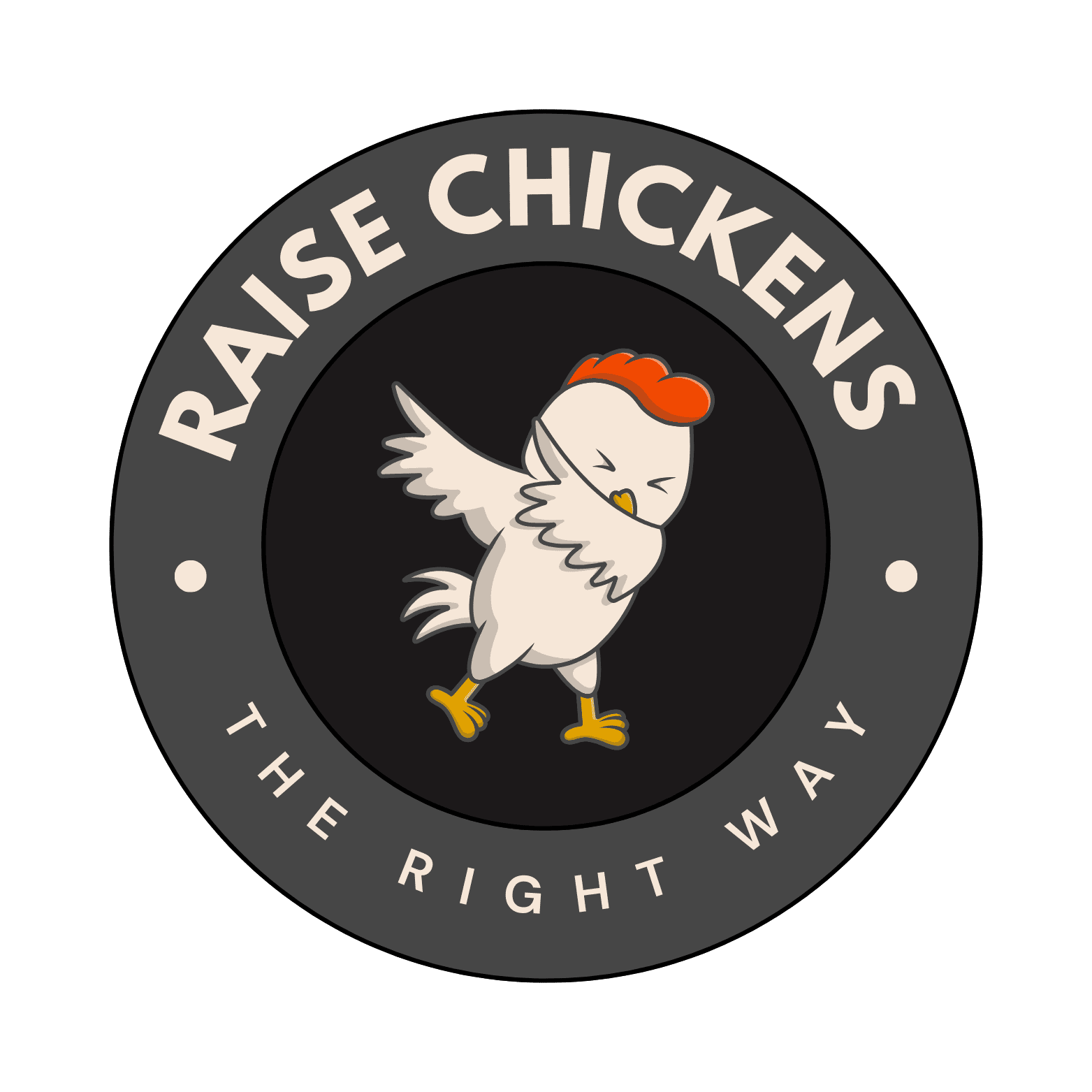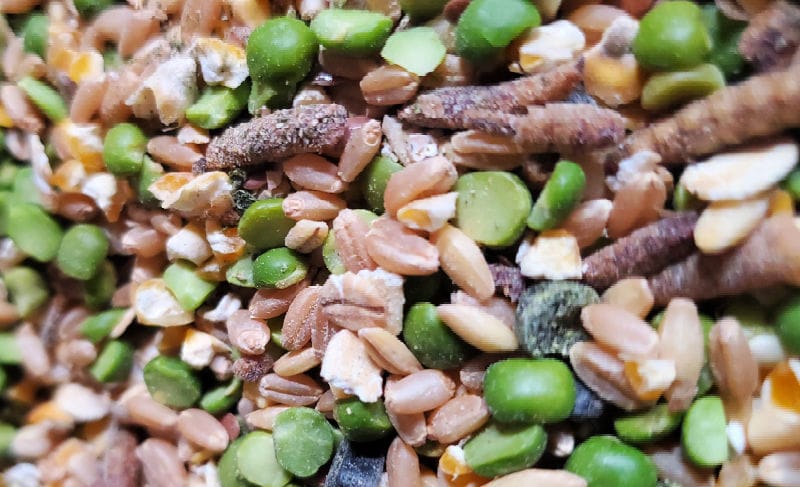Are you tired of spending too much on chicken feed? Many store-bought options can hit your wallet hard and contain unwanted additives. Our article guides you through crafting a nutritious, whole grain chicken feed mix that’s kind to your chickens and your budget.
Let’s get mixing!
The Benefits of Homemade Chicken Feed
Creating your own chicken feed can be a huge cost saver, and it often leads to a mix that’s higher in protein compared to commercial feeds.
Cost-effectiveness
Making your own chicken feed can save you money. It often costs less than store-bought feed. If you spend $62-73 per year on feeding a chicken, making it at home could be cheaper. You use grains like sunflower seeds, millet, and corn which might cost less when bought in bulk.
By mixing your own feed, you control the costs better. This means more cash stays in your pocket. Plus, farm-made feeds lower how much you spend on your chickens over time. Everyone likes to save money where they can, and DIY poultry feed is a smart way to do that!
Higher protein content
Chickens need protein to grow strong and healthy. Homemade chicken feed lets you control how much protein they get. Store-bought feeds often have set amounts, like 24% for baby chicks or 16% for egg layers.
But when you make your own, you can aim for the sweet spot your chickens need. For example, a good recipe might have about 17.5% protein from ingredients such as split peas and black oil sunflower seeds.
Getting this mix right helps your chickens stay in top shape. They’ll have better feathers and lay more eggs with enough protein in their diet. Let’s look at what goes into homemade feed that makes it so nutritious next.
Ingredients for Homemade Chicken Feed Mix
For a nutrient-packed homemade chicken feed mix, gather whole black oil sunflower seeds for healthy fats, white millet as a protein source, flax seed for omega-3s, hearty whole corn for energy, and fibrous whole oats.
Whole black oil sunflower seeds
Whole black oil sunflower seeds are a powerhouse of nutrition for chickens. They pack a lot of protein and essential minerals that your birds need to stay healthy and strong. Chickens love these seeds, much like they would enjoy a special treat.
With about 26% protein, black oil sunflower seeds help make your homemade feed very rich in this vital nutrient.
These tiny black seeds also have good fats that give chickens energy and help them look shiny and sleek. Since the fat content is around 11.8%, it means your feathered friends will get enough energy from their diet without needing too many extra snacks.
Let’s move on to another key ingredient – white millet!
White millet
Moving on from the nutritious black oil sunflower seeds, let’s talk about white millet. This tiny grain packs a powerful punch for your chickens’ health. White millet fits perfectly into soy-free and corn-free diets, making it an excellent choice for those looking to avoid these common allergens in poultry feed.
It’s full of good stuff that helps chickens grow strong and lay plenty of eggs.
Chickens love pecking at this small grain, which is great for their natural feeding behavior. Adding white millet to your homemade feed mix gives your birds a high-protein boost without relying on processed feeds.
It’s very cost-effective too; you can provide top-notch nutrition without breaking the bank. And if you’re raising broilers, including pearl millet can make up a big part of their diet while keeping them healthy and thriving.
Organic farmers also appreciate white millet as an organic option that supports eco-friendly farming practices.
Flaxseed
Flax seed is a superfood for chickens. This tiny brown or golden seed packs a lot of omega fatty acids, which are good for chickens and the eggs they lay. Adding flax seed to your homemade whole grain chicken feed helps make sure your birds get essential nutrients.
It’s great because it doesn’t have soy and keeps the mix natural and healthy.
Mixing flax seed into your poultry diet can lead to richer eggs from hens. Chickens eat this whole grain, then give you white eggs or brown ones that have more omega-3s in them. That means when you use flax seed in your feed, you’re also choosing what’s best for anyone who eats these eggs.
Next up, let’s talk about our next ingredient: Whole corn.
Whole corn
After the healthy boost from flax seed, whole corn adds energy to your chicken feed mix. Corn is a great grain for chickens that gives them lots of fuel. It’s full of carbs which help keep chickens active and warm, especially in colder weather.
But don’t give them too much! You’ll want to make sure they get other food too so their meals are balanced.
Whole corn is not just any ingredient; it plays a big role in homemade poultry feed. This grain helps your feathered friends stay strong and healthy. Since you’re making the feed at home, you can pick how much corn to use.
This way, your chickens get all they need without getting too fat or missing other important parts of their diet like protein from different sources.
Whole oats
Whole oats are a powerhouse of nutrition for your chickens. They pack in protein and important B vitamins that help keep your flock healthy. Oats also have calcium, which is good for laying hens to make strong eggshells, and fiber, which helps with digestion.
You can use whole oats to give your birds balanced nutrition. But it’s best not to only feed them oats because they need other food too. Think of oats as one part of a great meal plan for your birds.
Mix whole oats with other ingredients like black oil sunflower seeds or flax seed so that the chickens get everything they need to be happy and healthy.
Next up, let’s talk about another ingredient that makes homemade chicken feed special: “The Mixing Process”.
The Mixing Process
Pour your measured grains into a wheelbarrow and mix them thoroughly to ensure an even distribution of nutrients for your flock. Use a shovel or your hands to turn the mixture, combining the sunflower seeds, millet, flax seed, corn, and oats until you achieve a consistent blend.
This step is crucial in creating a balanced feed that will support the health and productivity of your chickens.
Using a wheelbarrow for convenience
A wheelbarrow can help you mix your chicken feed fast and with less work. You just need to put all the different seeds and grains into the wheelbarrow. Then, use a small shovel or your hands to stir everything together until it’s well mixed.
This way is not only easy but also saves money because you don’t have to buy big machines for mixing.
Having your feed in a wheelbarrow makes it simple to move it where you need it. Moving heavy bags of feed can be hard, but with a wheelbarrow, you can roll it right over to your chicken coop.
After mixing, head on to measuring the right amount your chickens will gobble up!
Measuring and mixing the ingredients
Get your ingredients ready – it’s time to mix. Grab a wheelbarrow or large container. This will make it easy to stir everything together without making a mess. Start by pouring in the whole grains, like corn and oats, which are the base of your chicken feed.
Add flax seeds for healthy fats and whole black oil sunflower seeds for extra protein.
Now, scoop white millet into the mix for variety. Measuring is key; you want to get the right balance so that your chickens get all they need from their meal. Use a shovel or your hands to blend everything evenly until you can’t tell one seed from another.
Stirring well makes sure each chicken gets its share of nutrients every peck at dinnertime! With the grain mixture ready, let’s think about how much you’ve made and where to store it safely.
Yield and Storage
Once your homemade chicken feed mix is ready, you’ll find that the recipe yields a generous amount suitable for small and large flocks alike. Store this nutritious bounty in a cool, dry place using sealed containers to maintain freshness and deter pests, ensuring your chickens enjoy the wholesome goodness batch after batch.
Amount of feed produced
Making your own chicken feed helps you control how much you make. You can mix a big batch or just enough for a week. The grains and seeds like corn, wheat, oats, and peas blend together to fill up your chickens’ feeder just right.
If you follow a recipe, it’s easy to see how much feed you get from the ingredients used.
Store this grain mixture properly to keep it fresh. You want your chickens to get good quality food every time they eat. Use clean, dry containers with tight lids. Keep them in a cool place away from sunlight and moisture.
This way, the nutritional requirements of your poultry are met each day without waste.
Storage recommendations
Keep your homemade chicken feed dry and fresh to save its goodness. Store it off the ground, maybe on a wooden pallet, to stop moisture from getting in. This helps you avoid feed degradation that happens when it’s stored on concrete floors.
Use containers with tight lids to keep out pests and water. If you have big amounts of grain, prepare grain bins correctly by making sure they are clean and dry before filling them up.
Make sure the bins are in a cool place away from direct sunlight to hold onto the nutritional value of your feed mix. Check the storage often for any signs of spoilage or bugs so your chickens always get top-quality food.
For long-term storage, be mindful of moisture control; this keeps your grains at their best for longer periods of time. Keeping feed in good shape means happy chickens and great eggs!
Conclusion
Making your own whole grain chicken feed mix is a great way to keep your chickens healthy. You control what goes into the mix, so you know it’s fresh and full of good stuff. Your birds will enjoy tasty, high-protein food that can help them grow strong and lay better eggs.
Plus, you’ll save money in the long run by mixing it yourself! So why not give it a try?.
FAQs
1. What grains can I use for homemade chicken feed?
You can use grains like corn, wheat, and oats in your homemade chicken feed mix.
2. Do I need to add anything else to the grain mix for my chickens?
Yes, you should add proteins like soybean meal or fishmeal and vitamins or minerals to make sure your chickens get all they need from the feed.
3. How do I know how much homemade feed to give my chickens?
The amount of feed depends on the size and age of your chickens, but usually it’s about 1/4 pound per chicken per day.
4. Can baby chicks eat whole grain chicken feed mix too?
No, baby chicks need a special starter feed that’s finer and has more protein than whole grain mixes meant for adult chickens.
5. Where can I store my homemade chicken feed mix so it stays fresh?
Store your homemade chicken feed in a cool, dry place away from rodents and pests in a sealed container or metal bin.

